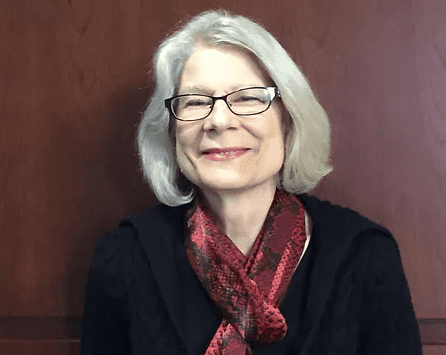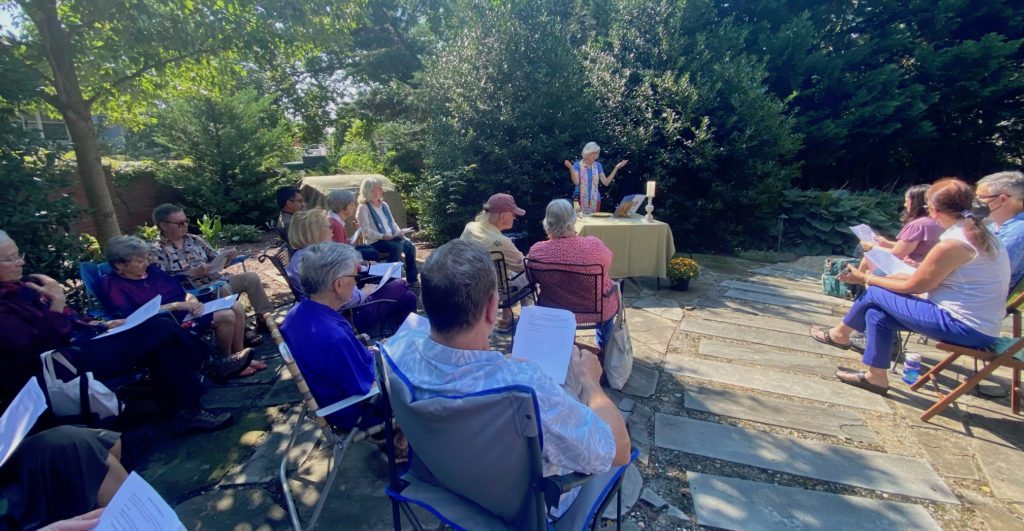
The Roman Catholic Church wears its age well — and yet, after 2,000 years, is still developing new features, still growing into its body. Perhaps, for world religions, 2,000 years seems like puberty: you’re at the age where lots of people know you and recognize you, but inside you’re expanding in ways that are still going to surprise them.
Georgetown is a place where some of the Catholic body’s most important parts can be found: two schools, two parishes and a world-famous university.
Now, this oldest neighborhood in Washington, D.C., is also home to a growing part of the Catholic Church that many Catholics would surely find a little surprising: women priests.
On Sunday morning, Sept. 18, in a secluded backyard garden on R Street, a community of Catholics gathered for what was likely the first ever Catholic Mass held in Georgetown celebrated by a woman.
Washington Home Inclusive Monthly Mass (WHIMM) organized the Mass and invited Rev. Kathleen Blank Riether to celebrate it. In person and remotely, roughly 30 Catholics prayed, read and worshiped, while sharing the sacrament of the Eucharist — the bread and wine — consecrated by the female Catholic priest.
“Sounds like heresy,” said an older member of Holy Trinity when I told him I was going. “My dad would probably say the same thing,” I replied with a smile. I went anyway.
I am not much of a rule breaker. I wasn’t even sure how comfortable I was going to WHIMM’s Mass in the first place. I am also a parishioner of Holy Trinity and attend daily Mass (not every day). I was born at Georgetown University Hospital and was raised in a conservative Catholic family. I was teased by my Italian grandmother for going to “pagan school” — I went to National Cathedral School. I graduated from Georgetown. And I am a disciplined former ballerina who likes to match her belt to her shoes and pay her credit card bill early.
It was at Holy Trinity where I first learned about WHIMM. A few months before the pandemic, WHIMM’s mission was shared with me at a lecture in the parish’s McKenna Hall about women in the early church. The lecture was co-hosted by the parish’s RCIA coordinator and a parishioner with a Ph.D. in theology from Catholic University, both women. When I learned how women were key evangelizers in the early church and were even ordained as deacons, these early Christian women reminded me of NCS’s former headmistress, Aggie Underwood, whose infamously intense academic environment taught us that — as women — we could do anything.
Catholics do not teach girls that they can do anything. If a girl raised in a Catholic church, who grows to love her church, is asked “What do you want to be when you grow up?” and she replies, “I want to become Pope,” the answer is, “No.” And yet, here I was, standing in a garden on R Street, witnessing a female Catholic priest bless me.

“We live in a finite, imperfect world in which every person and situation are an inextricable mix of both good and bad, right and wrong,” said Rev. Riether in her homily during Mass. “Though our minds want to automatically categorize people, situations, and things as right or wrong, good or bad, life is just not that simple… [Life] is a process of learning how to live with and negotiate the harsh realities of this world while upholding and living as fully as we can the teachings of Jesus.”
Reither belongs to Roman Catholic Womenpriest’s Eastern Region, an umbrella organization for the group of ten female Catholic priests called the Living Water Inclusive Catholic Community, the group from which WHIMM typically invites female priests. Based in Maryland, Living Water’s website states it began offering Masses in 2008 at the Unitarian Universalist Church in Annapolis and at the Stony Run Friends Meeting House in Baltimore. One of the leaders of Living Water is Andrea M. Johnson, a woman ordained deacon in 2005, priest in 2007, and now bishop as of 2009. Officially, the Catholic Church excommunicates women who are ordained priests. The ordained women claim the right of apostolic succession.)
Although WHIMM’s Masses are primarily celebrated in private homes, they also offer “Mass on Mass” for a larger gathering in an outdoor park on Massachusetts Avenue and Fulton Street NW. This open, public Mass is offered just steps from the Vatican Embassy, where participants walk to afterward for a short prayer service.
“The goal is not to just bemoan or dismantle what is broken,” says Jane Malhotra, WHIMM’s founder, “but to also build something better.” “Behold, I am making something new!” quotes the group on its website from Isaiah 43:19.
Malhotra was inspired by her aunt, Anne E. Patrick, and her book “On Being Unfinished,” where she explains a belief in creative responsibility: “a willingness to think deeply and originally… to take appropriate risks for the sake of promoting good…”. In that same spirit, Malhotra created WHIMM and through it a space for Catholics, who “want to renew the Church by experiencing a new model of ordained ministry.”
Malhotra’s creative responsibility is not unlike the prophetic obedience (another term coined by Malhotra’s aunt) followed by the women priests from Maryland’s Living Water Community: “Going towards the higher calling of conscience, towards the greater good, towards inclusive and divine justice and the dignity of all God’s creation, even if it means going against the rule of an institution.”
In December 2018, a group of Washington-area Catholics attended the first WHIMM Mass led by a woman priest at a home in Bethesda. In October 2019, the first public Mass was offered — “Mass on Mass” — in addition to ten home masses that year. By 2020, WHIMM Masses were celebrated in Arlington and Bethesda and continued remotely online during the pandemic.
At first, WHIMM started with about 15 Catholics. Then, Masses in private homes began collecting about 30 Catholics. Eventually, the Fulton Street public Mass gathered about 70 Catholics (“despite the rain”). Now, with an email list in the hundreds, a news crew filmed the Georgetown service, capturing attendees which WHIMM says exemplify a “growing community of Catholics seeking to live into the radical vision that Jesus calls us to, in unity with all God’s creation.”
So what is a WHIMM Mass like? Who was there? And what, if anything, was uniquely Georgetown about it?
At first, I felt like I was walking into a picnic (which perhaps, in its casual nature, isn’t too far from the Last Supper). A cardboard sign was taped to a tree to direct us where to walk to find the garden. A cheerful table was set up with mums for doughnut hour, complete with hot coffee and gluten-free pumpkin spice muffins from Trader Joe’s. The most notable culinary offering was actually the communion wine, a bottle of red with Snoop Dog’s face on it, which the label calls perfect for “rule breakers” and which the vintner calls “defiant by nature” and “bold in character.”
Everybody was lovely. The chairs were organized. The altar was recognizably set. The program was passed out. The readings, the psalm, the homily and the eucharist all played out like clockwork. But on this clock, there were some new features. There was no “Lord,” just “God” and “The Creator” (which sometimes took a feminine pronoun). The “Our Father” acknowledged both parents, beginning with “Our Father/Mother in heaven, hallowed be your name…”
Also, there was no unworthiness. Right about as we were to receive communion, instead of calling ourselves “unworthy,” we prayed a reminder that with Jesus we are worthy and that with his words we are healed. Though revised, the liturgy made perfect sense. It was as refreshing as it was heart-opening in a completely enlightened and still authentically Catholic way.

I could tell you that it was very Georgetown because of the Cartier watches, pearl necklaces, Celtic cross pendants, pinky rings, diamond earrings, Nantucket reds and chats about summer travel. (To be sure, the expected Tevas were there, too). But that wasn’t what made it Georgetonian. I thought back to how a 53 year-old John Carroll started building his school before he even officially owned the land. And it made me remember that it was a can-do, self-starting, proactive and hardworking American spirit that built a new country and which also originally defined the community living in Georgetown.
Perhaps, when I was presented with a torn piece of a gluten-free English muffin (instead of a cross-stamped wafer), and heard “the body of Christ” and said “Amen,” I had a hard time believing it really was the body of Christ. Maybe I was confused that there was no man in a robe initiating transubstantiation. But, do I need a man to tell me I am a part of the body of Christ? No. Indeed, I had no doubt that — in the group gathered around me — we were all a new (if a little unfamiliar) part of the body of Christ. And to my right, the older Catholic woman pinched up every crumb left in her palm and ate every morsel so as to not let any part of Jesus fall to the ground.
Complete Article ↪HERE↩!
